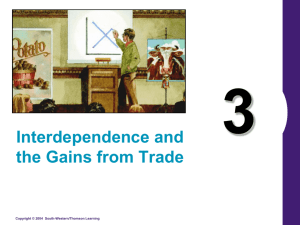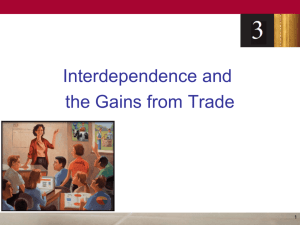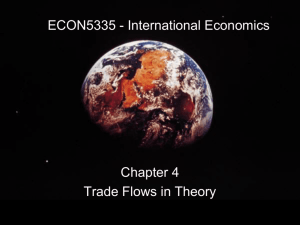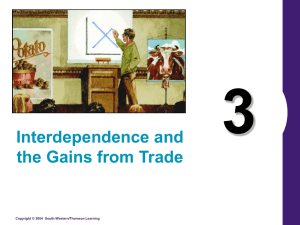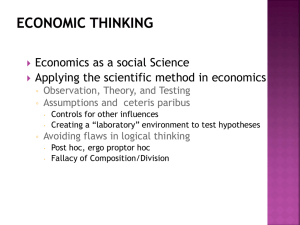• Why do people – and nations – choose to... economically interdependent? • How can trade make everyone better off?
advertisement
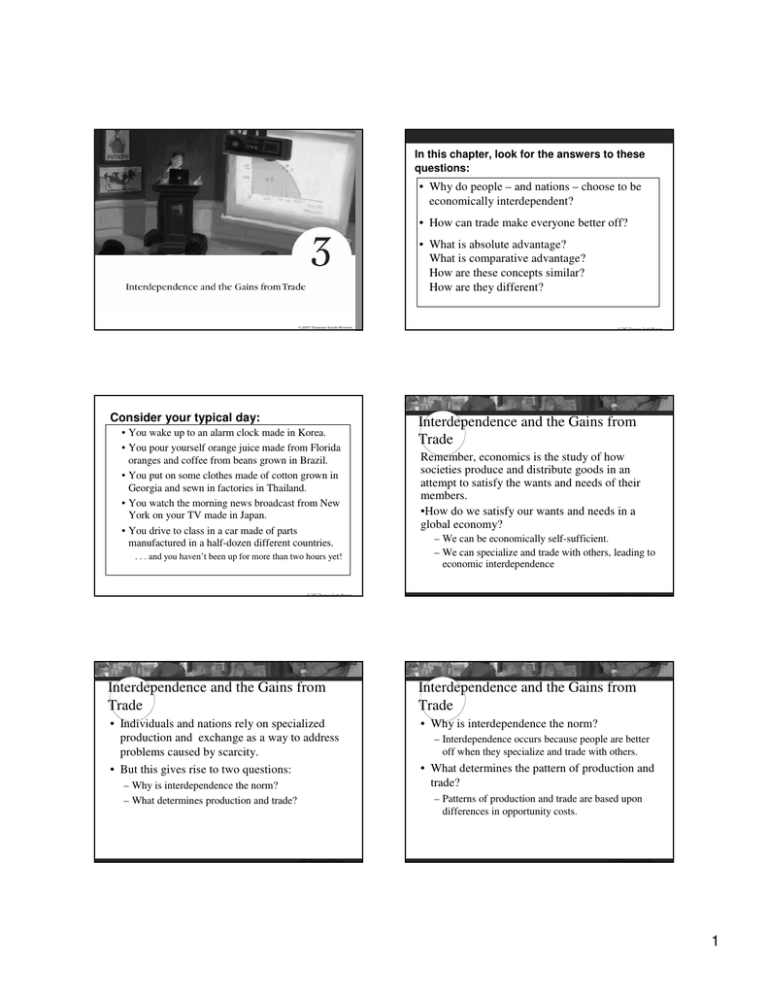
In this chapter, look for the answers to these questions: • Why do people – and nations – choose to be economically interdependent? • How can trade make everyone better off? • What is absolute advantage? What is comparative advantage? How are these concepts similar? How are they different? © 2007 Thomson South-Western Consider your typical day: • You wake up to an alarm clock made in Korea. • You pour yourself orange juice made from Florida oranges and coffee from beans grown in Brazil. • You put on some clothes made of cotton grown in Georgia and sewn in factories in Thailand. • You watch the morning news broadcast from New York on your TV made in Japan. • You drive to class in a car made of parts manufactured in a half-dozen different countries. . . . and you haven’t been up for more than two hours yet! © 2007 Thomson South-Western Interdependence and the Gains from Trade Remember, economics is the study of how societies produce and distribute goods in an attempt to satisfy the wants and needs of their members. •How do we satisfy our wants and needs in a global economy? – We can be economically self-sufficient. – We can specialize and trade with others, leading to economic interdependence © 2007 Thomson South-Western © 2007 Thomson South-Western Interdependence and the Gains from Trade Interdependence and the Gains from Trade • Individuals and nations rely on specialized production and exchange as a way to address problems caused by scarcity. • But this gives rise to two questions: • Why is interdependence the norm? – Why is interdependence the norm? – What determines production and trade? – Interdependence occurs because people are better off when they specialize and trade with others. • What determines the pattern of production and trade? – Patterns of production and trade are based upon differences in opportunity costs. © 2007 Thomson South-Western © 2007 Thomson South-Western 1 A PARABLE FOR THE MODERN ECONOMY Production Possibilities Imagine an economic system with only two goods, potatoes and meat and only two people, a potato farmer and a cattle rancher •What should each person produce? •Why should these people trade? • Suppose the farmer and rancher decide not to engage in trade: • Each consumes only what he or she can produce alone. • The production possibilities frontier is also the consumption possibilities frontier. • Without trade, economic gains are diminished. © 2007 Thomson South-Western Figure 1 The Production Possibilities Frontier © 2007 Thomson South-Western Figure 1 The Production Possibilities Curve (a) The Farmer ’s Production Possibilities Frontier (b) The Rancher ’s Production Possibilities Frontier Meat (ounces) Meat (ounces) 24 If there is no trade, the rancher chooses this production and consumption. If there is no trade, the farmer chooses this production and consumption. 8 4 0 12 B A 16 32 Potatoes (ounces) 0 24 © 2007 Thomson South-Western 48 Potatoes (ounces) © 2007 Thomson South-Western Copyright©2003 Southwestern/Thomson Learning Copyright©2003 Southwestern/Thomson Learning Specialization and Trade Production and Consumption Without Trade • Suppose instead the farmer and the rancher decide to specialize and trade… • Both would be better off if they specialize in producing the product they are more suited to produce, and then trade with each other. • How do we determine what good they are more The farmer should produce potatoes. suited to produce – Theory of Comparative Advantage The rancher should produce meat. © 2007 Thomson South-Western © 2007 Thomson South-Western 2 Absolute Advantage COMPARATIVE ADVANTAGE • The comparison among producers of a good according to their productivity. • Differences in the costs of production determine the following: – Who should produce what? – How much should be traded for each product? • Two ways to measure differences in costs of production: – The number of hours required to produce a unit of output (for example, one pound of potatoes). – The opportunity cost of sacrificing one good for another. © 2007 Thomson South-Western Opportunity Cost and Comparative Advantage • Compares producers of a good according to their opportunity cost, that is, what must be given up to obtain some item • The producer who has the smaller opportunity cost of producing a good is said to have a comparative advantage in producing that good. • Who has the comparative advantage in the production of each good? • Describes the productivity of one person, firm, or nation compared to that of another. • The producer that requires a smaller quantity of inputs to produce a good is said to have an absolute advantage in producing that good. • The Rancher needs only 10 minutes to produce an ounce of potatoes, whereas the Farmer needs 15 minutes. • The Rancher needs only 20 minutes to produce an ounce of meat, whereas the Farmer needs 60 minutes. © 2007 Thomson South-Western Comparative Advantage and Trade • Potato costs… • The Farmer’s opportunity cost of an ounce of potatoes is ¼ an ounce of meat. • The Rancher’s opportunity cost of an ounce of potatoes is ½ an ounce of meat. • Meat costs… • The Farmer’s opportunity cost of a pound of meat is 4 ounces of potatoes. • The Rancher’s opportunity cost of an ounce of meat is 2 ounces of potatoes... …so, the Rancher has a comparative advantage in the production of meat but the Farmer has a comparative advantage in the production of potatoes. © 2007 Thomson South-Western © 2007 Thomson South-Western Comparative Advantage and Trade Comparative Advantage and Trade • Comparative advantage and differences in opportunity costs are the basis for specialized production and trade. • Whenever potential trading parties have differences in opportunity costs, they can each benefit from trade. • In our example discussed above the rancher has a comparative advantage in the production of meat. This means that he will specialize in the production of meat, i.e., he will produce only meat and will not produce any potatoes, he will buy potatoes from the farmer. • The farmer has a comparative advantage in the production of potatoes. This means that he will specialize in the production of potatoes, i.e., he will produce only potatoes and will not produce any meat, he will buy meat from the farmer. • The next factor to be determined is the price at which the farmer and the rancher will exchange meat for potatoes. This will be determined by negotiations between the two individuals. • Let us assume that they negotiate a price of 1oz of meat for 3oz of potatoes. We will have to show that both the farmer and the rancher will benefit by trading at this price. © 2007 Thomson South-Western © 2007 Thomson South-Western 3 Comparative Advantage and Trade Comparative Advantage and Trade • Let us consider the farmer, who specializes in the production of potatoes, and buys meat from the rancher. Before he started trading, for each ounce of meat he produced, he would have to give up 4 oz of potatoes. However, once he starts trading, for each ounce of meat he now gives up only 3 oz of potatoes. • The price the farmer pays for the meat he buys from the rancher is less than what it would cost him to produce the meat if he did not trade. Therefore the farmer is better off when he trades with the rancher. • Let us consider the rancher, who specializes in the production of meat, and buys potatoes from the farmer. Before he started trading, for each ounce of potatoes he produced, he would have to give up 1/2 oz of meat. However, once he starts trading, for each ounce of potatoes he now gives up only 1/3 oz of meat (1oz of meat for 3oz of potatoes is the same as 1oz of potatoes for 1/3oz of meat). • The price the rancher pays for the potatoes he buys from the farmer is less than what it would cost him to produce the potatoes if he did not trade. Therefore the rancher is better off when he trades with the farmer. © 2007 Thomson South-Western © 2007 Thomson South-Western Comparative Advantage and Trade Gains from Trade • Benefits of Trade • Trade can benefit everyone in a society because it allows people to specialize in activities in which they have a comparative advantage. © 2007 Thomson South-Western © 2007 Thomson South-Western FYI—The Legacy of Adam Smith and David Ricardo • Adam Smith • In his 1776 book An Inquiry into the Nature and Causes of the Wealth of Nations, Adam Smith performed a detailed analysis of trade and economic interdependence, which economists still adhere to today. • David Ricardo • In his 1816 book Principles of Political Economy and Taxation, David Ricardo developed the principle of comparative advantage as we know it today. © 2007 Thomson South-Western APPLICATIONS OF COMPARATIVE ADVANTAGE • Should Tiger Woods Mow His Own Lawn? • Given Wood's athleticism, it is entirely possible that he could mow his lawn faster than most men. This implies that he has an absolute advantage. • However, if the opportunity cost of his time is $10,000 (his pay to film a commercial for Nike), it is likely that someone else will have a comparative advantage in mowing his lawn. • Both he and the person hired will be better off as long as he pays the individual more than the individual's opportunity cost and less than $10,000. © 2007 Thomson South-Western 4 APPLICATIONS OF COMPARATIVE ADVANTAGE Should the United States trade with other countries? • Each country has many citizens with different interests. International trade can make some individuals worse off, even as it makes the country as a whole better off. – Imports—goods produced abroad and sold domestically – Exports—goods produced domestically and sold abroad The principle of comparative advantage suggests that each good should be produced by the country with a comparative advantage in producing that good (smaller opportunity cost). Through specialization and trade, countries can have more of all goods to consume. Trade issues among nations are more complex. Individuals can be made worse off even when the country as a whole is made better off. © 2007 Thomson South-Western 5


